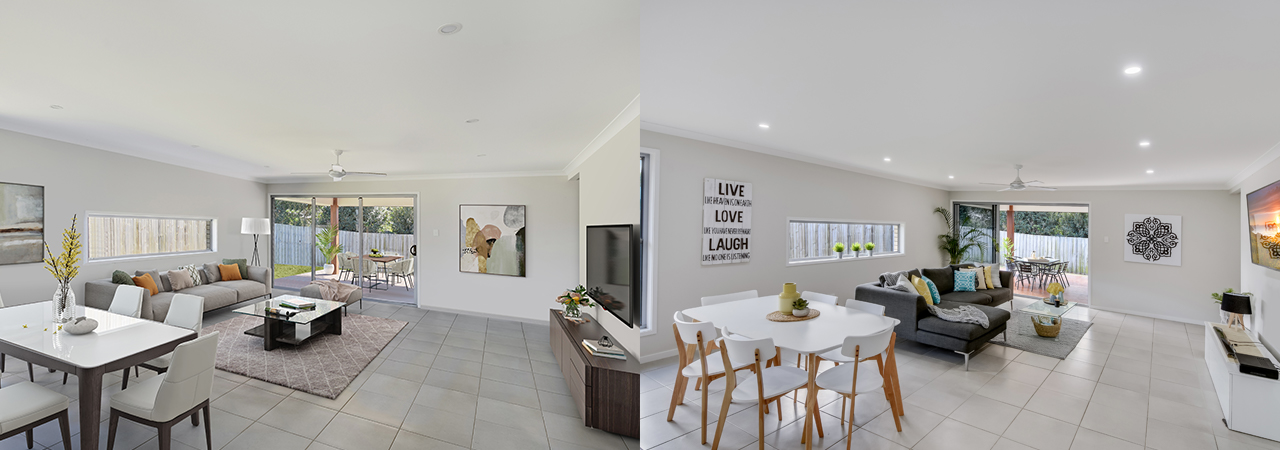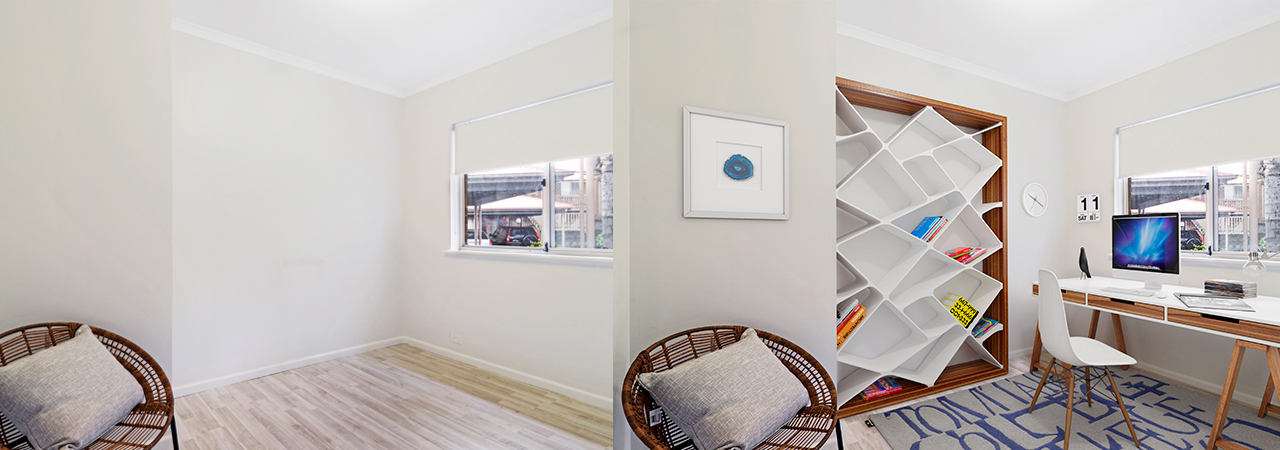HOW VIRTUAL STAGING WORKS
Agents should always be on the lookout for improved ways of attracting buyers to their properties. Home staging has long been proven as an effective way of attracting higher sale prices and lower times on the market, but historically has only been used for high-end properties due to its cost.
With the advance of technology, Virtual Staging has now become a popular option for those that don’t want to pay the high price of traditional staging or have time restrictions.
What Is Virtual Staging?
Staging is where a property is decorated to display the buildings best qualities with the intention of attracting buyers. Like painting a house and updating the landscaping, it’s goal to sell a home faster at a higher price. According to a 2017 survey by the National Association of Realtors, a majority of real estate professionals believe staging increases the sale price of the home anywhere from 1 to 15 percent.
Virtual Staging, works in much the same way, as it is the process of enhancing digital photos of a property by using graphics software (like that used for 3D movies) to digitally build furniture into an image. Like traditional staging, anything can be added, from wall hangings, rugs to beds and sofas.

Why Virtual Staging Works
Homes photographed empty can be deceiving due to rooms either looking larger or smaller than they are. Therefore, Virtual Staging is a great option, because it provides realtors with the ability to display a ‘before’ image of the empty room, and an ‘after’ image of the staged room. Giving potentials buyers the opportunity to see all aspects of the room, such as air-vents, power points, light switches, in addition to room perspective. It is important to make your images stand out online, with research suggesting that 9 out of 10 buyers start their property search online.
Virtual Staging is never a substitute for getting the property ready via traditional means, such as painting, repairs, maintenance and small renovations. Virtual Staging is about assisting buyers with viewing the property as if they have styled it themselves. At the same time, you want to remove too many of the personal elements of the home (photos, worn lounges, knick knacks), but give it a bit of character with a designer look.
Providing images, at the open home and online, of the room before and after it has been staged is a great way of helping buyers visualize the house with their new furniture in it. Viewers can often be overwhelmed with property viewings, so by making it easy to get a feel for what will fit in a room.
Virtual Staging Vs Traditional Staging
If you can afford traditional staging and it fits within the budget of the home seller, you will always be better off with the real thing. In many cases, especially with rental properties or lower priced listings, Virtual Staging is the best option. Buyers are more likely to spend $32 per image on Virtual Staging, than $600 per room on traditional staging.
Traditional staging will enable the buyer to view the property as they saw it online, which can reduce any unintentional surprises. Virtually Staged photos are great, but it is important to not make the photos look radically different from the real home. Drastically changed photos can attract claims of false advertising and even reduce the perceived value of the home.

First image: A Virtually Stage Room Second Image: Traditionally Staged Room
Key Requirements For Virtually Staging a Property
Staging a home virtually isn’t about photo-shopping some furniture in, it involves professional photos and skilled designers with years of experience. These are the two key things you need to get the best Virtual Staging outcomes:
- Professional Photos – The most realistic Virtually Staged houses have used professionally taken photos as a base. High-quality photos are needed to be able to make the furniture look realistic. Professional photographers are also skilled at taking photos of empty rooms with the best angles for staging, such as providing photos with more floor space visible.
- Reference Images – Everyone’s style and tastes vary, also it's hard to know what style will suit a property if you can’t see it physically. When uploading photos to be staged BoxBrownie.com provide a variety of styles to choose from (Modern/Contemporary, Urban/Industrial, Scandinavian and Farmhouse), but it is always good practice to upload images of the type of furniture and style you prefer. Our editors can then try and match it as close as possible.
In addition to a reference image, it can be good to draw on one of the reference images where you want the furniture placed or provide a description. Editors often don’t know what is behind the photographer, so can’t tell the flow of a room, especially if there are no doors visible.
Working With Partly Furnished Rooms
Virtual Staging is flexible in that you can work with current furniture still

2018 Staging Trends
Interior design trends are constantly changing, and these apply to Virtual Staging just as much as traditional staging. When staging a home, it is important to consider the overall style and design of the home, in addition to
Here are a few trends that are becoming popular in 2018:
- Adding color – Including a pop of color can change the look and feel of a room. This can be as easy as adding some bright colored cushions, and wall decorations.
- Neutral tones - Keep base colors neutral. When Virtually Staging you want to ensure the colour theme suits a variety of tastes.
- Copper Accents – Including copper elements in your home adds a classy element. It doesn’t have to be much, just something like a wall clock, or a side lamp.
- Floral Prints – Traditional floral prints are becoming more popular. Keeping inline with the floral theme, but without over doing it is easy if you just stick to a few things like, cushions and wall prints.
If you’re having trouble selling a listing why not give Virtual Staging a try?
Proven to increase online views and reduce a homes time on the market, it is one of the easiest and most cost-effective ways of boosting your sales.